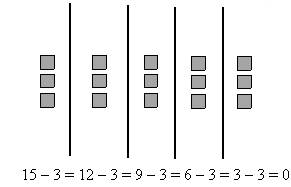| 15 | : | 3 | = | 5 |
| fifteen | divided by | three | equals | five |
| dividend | : | divisor | = | quotient |
Multiplication undoes division and division undoes multiplication. In other words, since 3
![]() 5 = 15, then 15
5 = 15, then 15
![]() 5 = 3. Since division and multiplication are inverse
operations, students can use models similar to the models used in multiplication, to divide. In the expression 15
5 = 3. Since division and multiplication are inverse
operations, students can use models similar to the models used in multiplication, to divide. In the expression 15
![]() 3, you begin with fifteen items and want to know how many groups you can make with three items in each group. The answer, or
quotient, is the number of groups.
3, you begin with fifteen items and want to know how many groups you can make with three items in each group. The answer, or
quotient, is the number of groups.

|
15
|
Since multiplication is a form of repeated addition, division is a form of repeated subtraction. For example, 15
![]() 3 asks you to repeatedly subtract 3 from 15 until you reach zero: 15 - 3 = 12 - 3 = 9 - 3
= 6 - 3 = 3 - 3 = 0. This process required 3 to be subtracted 5 consecutive times, so again we see that
3 asks you to repeatedly subtract 3 from 15 until you reach zero: 15 - 3 = 12 - 3 = 9 - 3
= 6 - 3 = 3 - 3 = 0. This process required 3 to be subtracted 5 consecutive times, so again we see that ![]() 3 = 5.
3 = 5.
|
|
The result of division is to separate a group of objects into several equal smaller groups. The starting group is called the dividend. The number of groups that are separated out is called the divisor. The number of objects in each smaller group is called the quotient.The results of division can be obtained by repeated subtraction. If we are separating 24 objects into 6 equal groups of four, we would take (or subtract) four objects at a time from the large group and place them in 6 equal groups. In mathematical terms this would be: 24-4-4-4-4-4-4.